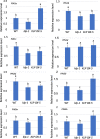Loose Plant Architecture 1-Interacting Kinesin-like Protein KLP Promotes Rice Resistance to Sheath Blight Disease
- PMID: 34215911
- PMCID: PMC8253871
- DOI: 10.1186/s12284-021-00505-9
Loose Plant Architecture 1-Interacting Kinesin-like Protein KLP Promotes Rice Resistance to Sheath Blight Disease
Abstract
Background: Sheath blight disease (ShB) is a destructive disease affecting rice production. Previously, we have reported that Loose Plant Architecture 1 (LPA1) promotes resistance to ShB. However, the mechanisms by which LPA1 confers resistance against this disease have not been extensively investigated. Notably, interactors that regulate LPA-1 activity remain elusive.
Findings: In this study, we identified the interaction of kinesin-like protein (KLP) with LPA1 in the nucleus of rice cells by yeast two-hybrid, bimolecular fluorescent complimentary (BiFC), and co-immunoprecipitation (co-IP) assays. To investigate the role of KLP in promoting resistance to ShB, wild-type, klp mutant, and KLP overexpressor (KLP OX) rice plants were inoculated with Rhizoctonia solani AG1-IA. The results indicated that, compared with the wild-type control, klp mutants were more susceptible while KLP OX plants were less susceptible to ShB. Since LPA1 transcriptionally activates PIN-FORMED 1a (PIN1a), we examined the expression of 8 related PIN genes. The results showed that only the expression of PIN1a and PIN3b coincided with KLP expression levels. In addition, a chromatin immunoprecipitation (ChIP) assay showed that KLP bound directly to the promoter region of PIN1a but not of PIN3b. Transient expression assays confirmed that LPA1 and KLP transcriptionally activate PIN1a, and that coexpression of KLP and LPA1 had an additive effect on the activation of PIN1a, suggesting that KLP enhances LPA1 transcriptional activation activity.
Conclusions: Taken together, our results show that KLP is a novel LPA1 interactor that promotes resistance of rice to ShB.
Keywords: Defense; KLP; Rice; Sheath blight disease; Transcription activation.
Conflict of interest statement
The authors declare no conflict of interest.
Figures




References
-
- Kouzai Y, Kimura M, Watanabe M, Kusunoki K, Osaka D, Suzuki T, Matsui H, Yamamoto M, Ichinose Y, Toyoda K, Matsuura T, Mori IC, Hirayama T, Minami E, Nishizawa Y, Inoue K, Onda Y, Mochida K, Noutoshi Y. Salicylic acid-dependent immunity contributes to resistance against Rhizoctonia solani, a necrotrophic fungal agent of sheath blight, in rice and Brachypodium distachyon. New Phytol. 2018;217(2):771–783. doi: 10.1111/nph.14849. - DOI - PMC - PubMed
-
- Li J, Jiang J, Qian Q, Xu Y, Zhang C, Xiao J, Du C, Luo W, Zou G, Chen M, Huang Y, Feng Y, Cheng Z, Yuan M, Chong K. Mutation of rice BC12/GDD1, which encodes a kinesin-like protein that binds to a GA biosynthesis gene promoter, leads to dwarfism with impaired cell elongation. Plant Cell. 2011;23(2):628–640. doi: 10.1105/tpc.110.081901. - DOI - PMC - PubMed
Grants and funding
LinkOut - more resources
Full Text Sources
Miscellaneous

